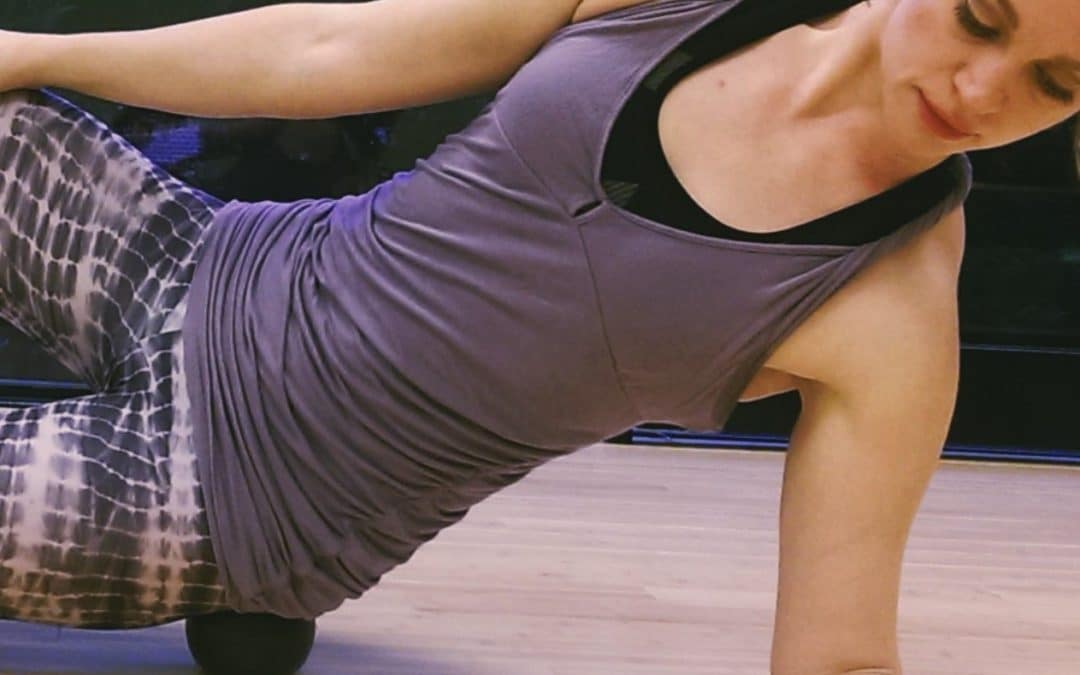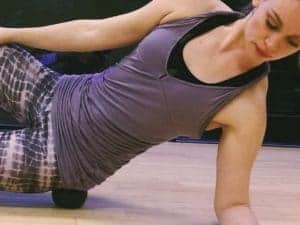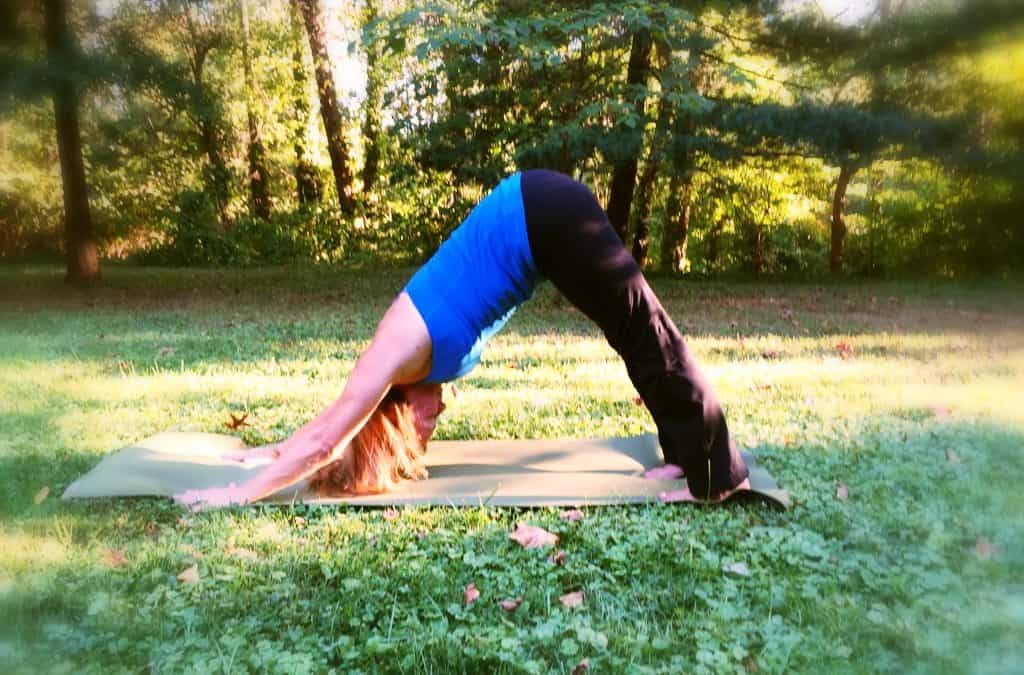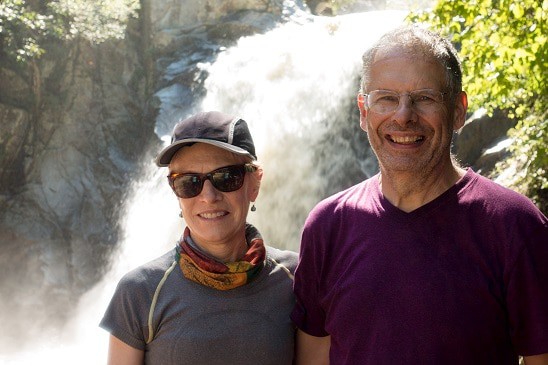
by SyteraYoga | Aug 20, 2018
A set of body rolling balls arrived on our doorstep and my husband freaked out. At the gym he has rolled a lacrosse ball across his back and shoulders to loosen the muscles. So, the prospect of fixing the “issues in his tissues” with a new type of rolling sphere was super appealing. A lot of people feel the same way. Body rolling is becoming increasingly popular in gyms and studios across the country. But what exactly is it?
Body rolling was first popularized in 1979 by a yoga teacher and bodyworker in Manhattan who was interested in healing herself after a hip injury. She believed that we are all walking around with a lot of muscle imbalance from chronic stress and old injuries (think laptop hunch, driving slouch, clenched back, etc.). By rolling out the muscles and tissues with a ball, a person could use knowledge of one’s own injuries and aches to reprogram stuck, unhealthy patterns in the body and restore a sense of balance.
The idea is to let the flesh, muscle, and tendon sink around the ball, and then work into tight, crunchy knots and muscle fibers. This allows for the fascia—the thin sheath of fibrous tissue around the muscles and organs—to loosen and reshape. Sound good? There’s more!
Since the balls are three dimensional, they can target areas that are hard to reach with traditional stretching and foam rolling. The balls massage the tendons, ligaments, bones, and even organs and the nervous system, stimulating blood flow. Pressing the ball into the abdomen and ribs, for example, can affect the large and small intestine, promoting healthy digestion. On top of that, the balls work in and around joints and vertebrae, creating space where there is unhealthy compression.
 Sytera Field, who started teaching yoga body rolling nine years ago, considers herself a guide. Students have the control over the pressure and intensity of the practice, which is important because there are going to be mental and physical challenges. “You are asking your body to do something different and there is a conflict there,” she says. “There’s a resistance, and you have to decide if you are ready to let go of it. You have to be quiet enough in your mind to decipher the messages that you are getting and whether the sensations are productive or unproductive.”
Sytera studied Thai Yoga Massage in her hometown of Austin. She views body rolling as a form of giving oneself a Thai Yoga Massage. Body rolling is incredibly therapeutic because you get the benefits of stretching and massage at the same time.
Nici Bush, a SyteraYoga student who travels internationally for her job, body rolls regularly. She tosses a set of balls in her suitcase, and after flights she rolls the balls down her back, over her hamstrings, and into the constrictions in her neck and shoulders. After that, it’s easier to get into her yoga practice, and there is a better connection to the floor in standing poses. There are mental benefits, too. She says she gets that same floating feeling that you experience after receiving a professional massage.
At my house, I broke open the package of yoga balls and started rolling. Things started to shift. When I stood up, my legs weren’t tight in the same areas and I felt lighter. My shoulders moved back and there was more room for my belly to rise and fall with my breath.
My husband was going to try next, but then the puppy got to them. Did I mention that the balls are rubbery? We will be ordering a new set. For now, my husband has to wait.
Meghan Mullan is a freelance writer and SyteraYoga student.
Sytera Field, who started teaching yoga body rolling nine years ago, considers herself a guide. Students have the control over the pressure and intensity of the practice, which is important because there are going to be mental and physical challenges. “You are asking your body to do something different and there is a conflict there,” she says. “There’s a resistance, and you have to decide if you are ready to let go of it. You have to be quiet enough in your mind to decipher the messages that you are getting and whether the sensations are productive or unproductive.”
Sytera studied Thai Yoga Massage in her hometown of Austin. She views body rolling as a form of giving oneself a Thai Yoga Massage. Body rolling is incredibly therapeutic because you get the benefits of stretching and massage at the same time.
Nici Bush, a SyteraYoga student who travels internationally for her job, body rolls regularly. She tosses a set of balls in her suitcase, and after flights she rolls the balls down her back, over her hamstrings, and into the constrictions in her neck and shoulders. After that, it’s easier to get into her yoga practice, and there is a better connection to the floor in standing poses. There are mental benefits, too. She says she gets that same floating feeling that you experience after receiving a professional massage.
At my house, I broke open the package of yoga balls and started rolling. Things started to shift. When I stood up, my legs weren’t tight in the same areas and I felt lighter. My shoulders moved back and there was more room for my belly to rise and fall with my breath.
My husband was going to try next, but then the puppy got to them. Did I mention that the balls are rubbery? We will be ordering a new set. For now, my husband has to wait.
Meghan Mullan is a freelance writer and SyteraYoga student.

by SyteraYoga | Jun 20, 2018
Everyone has a story to tell, and Zaiba Hasan wants to hear it. Zaiba, a regular and friendly face in the SyteraYoga community, is an open person by nature and can be found volunteering, parenting, and listening to the many people she calls her friends..
Zaiba is the kind of person you call when you need to find enough furniture to set up an apartment for a refugee family of six who are relocating to the area. She is also the mom who is always ready to help her kids’ friends. On the weekend her house is a place where visitors can drop by at any time; she’d never turned anyone away.
It’s important for Zaiba to be completely honest about why she does this—she’s all about building community. She likes to be around people who enjoy helping other people and she likes to be around people in general.
Zaiba is a mother of four children, ages 14, 12, 7 and 5. She heads an event marketing firm and volunteers for local nonprofits including Kindworks, an organization that supports refugees.
Zaiba is Muslim and of Irish and Pakistani descent. As a result, she can relate to people of all backgrounds and takes pride in being able to surround herself with a diverse circle of friends. “How lucky am I?!”
But, it wasn’t always like that. When she moved from Chicago to the D.C. area in 2003 with her husband and an infant, she was trying to mother all by herself and it wasn’t going well.
Since her old community was no longer nearby, she decided to build a new one.
Influenced by her father-in-law, a medical anthropologist, Zaiba says she knew that she had to have a community to be a better mother. America is unique place where women feel the need to do all the mothering without help, she said. “Plop down in any other country in the world and women have extended family and hired help.”
An increasing amount of evidence indicates a link between community and health. Studies show that being in a supportive group generates a positive feedback loop of social, emotional, and physical well-being. Conversely, not having a community can have serious negative health consequences.
Zaiba faced health challenges after the birth of her son in 2013. The baby suffered from a complicated birth and ended up in the intensive care unit for two weeks. He developed gallbladder disease, and breastfeeding didn’t go well. She was exhausted and frustrated that she wasn’t losing any of the baby weight. Then she found out that she had benign tumors growing on her thyroid that were wreaking havoc on her metabolism.
She was suffering from anxiety at this point and realized she needed to reach out.
“I think that most people suffer from anxiety and they don’t really talk about it,” she said. Some of the people around her suggested that she try yoga but she didn’t really want to since she didn’t see it as way to get adequate exercise. She had practiced kickboxing previously.
But, she decided to try a class at a nearby studio taught by Sytera, and was immediately impressed. Yoga, in theory, is an introspective practice, so the fact that there was an outward community at the class speaks volumes to what Sytera is trying to do, she said. She found that people talked to each other after class and seemed to really care about her. In particular, meeting people at SyteraYoga has helped her deal with what teenagers like her kids are going through, which is essential, she said.
It’s incredible what type of people come into SyteraYoga, she said. And when she allows herself to be open and humble, she is amazed at what she learns from other people. And that is the beauty of a community.
Meghan Mullan is a freelance writer and a SyteraYoga student.

by SyteraYoga | Apr 22, 2018
Be honest, haven’t you always wanted to howl during upward-facing dog pose? Well, now you can! It’s called family yoga, where adults are encouraged to yuck it up. And, as for the kids, they’ve been doing this for years—it’s called being a kid.
This is the “yes zone,” where abundant energy and brazen silliness are welcome, says SyteraYoga teacher Marci Love Thomas. But not to fear: there are still traditional asanas in family yoga. There are sun salutations and standing poses like warrior II—better known as “surfing.” The breathing elements are there, you know, “smelling the poopy diaper.” And what about partner poses? Yes, you’ll get to be part of a human bunk bed! Now that sounds like fun (if you’re not the bottom bunk). (more…)

by SyteraYoga | Mar 24, 2018
At an art class at the Corcoran in 2005, Carolee Jakes knew that her life’s direction was about to change. Before then, she had been a career nurse, a stay-at-home mom, and “a person who did a lot of PTA activities,” she explained.
At that class, the first of many, she felt like she belonged. She quickly enrolled in art school and then she discovered yoga. The two pursuits would soon become linked. (more…)

by SyteraYoga | Feb 26, 2018
Everyone has a different reason for beginning yoga. In the case of SyteraYoga teacher Kathy Low, it was a colicky baby.
Kathy had taken many styles of yoga since 1998, but it wasn’t until she ended up in an Ashtanga yoga class in 2007 that she began to see the light at the end of the baby tunnel. She found Ashtanga to be a quiet, less complicated and, therefore, more centering yoga practice. (more…)

by SyteraYoga | Feb 3, 2018
Not everyone’s husband will join them on a weeklong, mostly-female, vegan yoga retreat. But SyteraYoga student Mary Saunders is lucky. Her husband Rick did just that. A career Army officer and former national security advisor to the Vice President, Rick had just recently cut back on his consulting work and started taking more yoga classes when she suggested that they go. (more…)

 Sytera Field, who started teaching yoga body rolling nine years ago, considers herself a guide. Students have the control over the pressure and intensity of the practice, which is important because there are going to be mental and physical challenges. “You are asking your body to do something different and there is a conflict there,” she says. “There’s a resistance, and you have to decide if you are ready to let go of it. You have to be quiet enough in your mind to decipher the messages that you are getting and whether the sensations are productive or unproductive.”
Sytera studied Thai Yoga Massage in her hometown of Austin. She views body rolling as a form of giving oneself a Thai Yoga Massage. Body rolling is incredibly therapeutic because you get the benefits of stretching and massage at the same time.
Nici Bush, a SyteraYoga student who travels internationally for her job, body rolls regularly. She tosses a set of balls in her suitcase, and after flights she rolls the balls down her back, over her hamstrings, and into the constrictions in her neck and shoulders. After that, it’s easier to get into her yoga practice, and there is a better connection to the floor in standing poses. There are mental benefits, too. She says she gets that same floating feeling that you experience after receiving a professional massage.
At my house, I broke open the package of yoga balls and started rolling. Things started to shift. When I stood up, my legs weren’t tight in the same areas and I felt lighter. My shoulders moved back and there was more room for my belly to rise and fall with my breath.
My husband was going to try next, but then the puppy got to them. Did I mention that the balls are rubbery? We will be ordering a new set. For now, my husband has to wait.
Meghan Mullan is a freelance writer and SyteraYoga student.
Sytera Field, who started teaching yoga body rolling nine years ago, considers herself a guide. Students have the control over the pressure and intensity of the practice, which is important because there are going to be mental and physical challenges. “You are asking your body to do something different and there is a conflict there,” she says. “There’s a resistance, and you have to decide if you are ready to let go of it. You have to be quiet enough in your mind to decipher the messages that you are getting and whether the sensations are productive or unproductive.”
Sytera studied Thai Yoga Massage in her hometown of Austin. She views body rolling as a form of giving oneself a Thai Yoga Massage. Body rolling is incredibly therapeutic because you get the benefits of stretching and massage at the same time.
Nici Bush, a SyteraYoga student who travels internationally for her job, body rolls regularly. She tosses a set of balls in her suitcase, and after flights she rolls the balls down her back, over her hamstrings, and into the constrictions in her neck and shoulders. After that, it’s easier to get into her yoga practice, and there is a better connection to the floor in standing poses. There are mental benefits, too. She says she gets that same floating feeling that you experience after receiving a professional massage.
At my house, I broke open the package of yoga balls and started rolling. Things started to shift. When I stood up, my legs weren’t tight in the same areas and I felt lighter. My shoulders moved back and there was more room for my belly to rise and fall with my breath.
My husband was going to try next, but then the puppy got to them. Did I mention that the balls are rubbery? We will be ordering a new set. For now, my husband has to wait.
Meghan Mullan is a freelance writer and SyteraYoga student.




